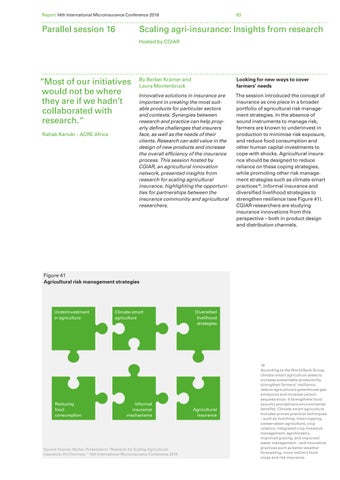Report 14th International Microinsurance Conference 2018
Parallel session 16
83
Scaling agri-insurance: Insights from research Hosted by CGIAR
“Most of our initiatives would not be where they are if we hadn’t collaborated with research.“ Rahab Kariuki – ACRE Africa
By Berber Kramer and Laura Montenbruck
Looking for new ways to cover farmers’ needs
Innovative solutions in insurance are important in creating the most suitable products for particular sectors and contexts. Synergies between research and practice can help properly define challenges that insurers face, as well as the needs of their clients. Research can add value in the design of new products and increase the overall efficiency of the insurance process. This session hosted by CGIAR, an agricultural innovation network, presented insights from research for scaling agricultural insurance, highlighting the opportunities for partnerships between the insurance community and agricultural researchers.
The session introduced the concept of insurance as one piece in a broader portfolio of agricultural risk management strategies. In the absence of sound instruments to manage risk, farmers are known to underinvest in production to minimise risk exposure, and reduce food consumption and other human capital investments to cope with shocks. Agricultural insurance should be designed to reduce reliance on these coping strategies, while promoting other risk management strategies such as climate-smart practices18, informal insurance and diversified livelihood strategies to strengthen resilience (see Figure 41). CGIAR researchers are studying insurance innovations from this perspective – both in product design and distribution channels.
Figure 41 Agricultural risk management strategies
Underinvestment in agriculture
Reducing food consumption
Climate-smart agriculture
Informal insurance mechanisms
Source: Kramer, Berber. Presentation “Research for Scaling Agricultural Insurance: An Overview.” 14th International Microinsurance Conference 2018
Diversified livelihood strategies
Agricultural insurance
18 According to the World Bank Group, climate-smart agriculture seeks to increase sustainable productivity, strengthen farmers’ resilience, reduce agriculture’s greenhouse gas emissions and increase carbon sequestration. It strengthens food security and delivers environmental benefits. Climate-smart agriculture includes proven practical techniques – such as mulching, intercropping, conservation agriculture, crop rotation, integrated crop-livestock management, agroforestry, improved grazing, and improved water management – and innovative practices such as better weather forecasting, more resilient food crops and risk insurance.























